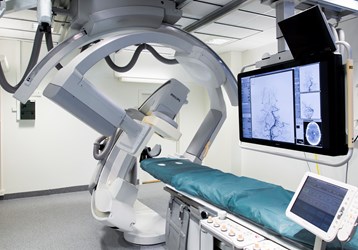New Philips NeuroSuite Reveals The Brain's Vascular Network Like Never Before

- NeuroSuite interventional X-ray system enhances minimally invasive neurological treatment
- Solution supports more effective device guidance and placement in live image-guided neuroradiology procedures, extending treatment options
- First installation at Karolinska University Hospital Sweden
Royal Philips recently announced the introduction of NeuroSuite, a new integrated solution designed to support and enhance minimally invasive image-guided neurological interventions, a fast growing market with a compound annual growth rate of around 9 percent. Philips’ new interventional X-ray solution offers more effective device guidance and placement in every neuroradiology procedure.
The first NeuroSuite system was recently installed at Karolinska University Hospital, Stockholm, Sweden. This hospital is one of the world´s leading medical universities and a center of excellence for stroke treatment.
Neuroradiology is a branch of radiology that involves the diagnosis and minimally invasive treatment of the brain, head, neck and spine. These treatments require the insertion of a catheter, which must be navigated through a very narrow (with vessels less than 2 mm wide) and tortuous vasculature to the treatment site with the aid of live image guidance. New devices (e.g. stents and flow diverters) offer new treatments for ischemic stroke or large neck aneurism, but their increasingly smaller designs make the devices more difficult to see with X-ray imaging. This can present additional challenges for placement and treatment assessment.
To cope with these challenges Philips’ NeuroSuite consists of a bi-plane interventional X-ray system with a unique combination of two new detectors: Philips’ frontal FD20 detector delivers live 2D and 3D imaging to provide live navigation and immediate therapy feedback. The smaller, lateral FD15 detector can be positioned beyond the shoulders and very close to the head. This shorter distance and unique combination of detectors provides sharp, full brain imaging at lower X-ray dose and 3D imaging optimized for neuro and spine interventions.
“In image-guided interventions the ultimate goal is to see clearly and navigate effectively, while managing X-ray dose for patients, staff and clinicians,” says Ronald Tabaksblat, General Manager Interventional X-ray at Philips Healthcare. “Developed in collaboration with clinical partners around the world, Philips NeuroSuite has been designed for that purpose and underpins Philips’ global leadership position in live-image guidance technologies.”
“In interventional neuroradiology the performance of the angiographic system is crucial to patient safety,” says Dr Michael Söderman, Associate Professor and Chief of Neuroangiography and Stereotaxy, Department of Neuroradiology, Karolinska University Hospital. “Philips’ latest innovation is NeuroSuite with a new 20 inch detector on the frontal plane, providing superb 3D-images and big enough for spine imaging. On the lateral plane, the new 15 inch detector brings visualization of the complete cerebral vasculature, with reduced collision risks and enhanced projection freedom.”
At the heart of NeuroSuite is Philips AlluraClarity, lowering radiation dose by as much as 73 percent without compromising image quality ² ³: and VasoCT that visualizes intracranial devices in vessel context and vessel morphology down to perforator vessels¹.
“Over the last years a lot of progress was made on high resolution device visualization”, says Professor Jacques Moret of the faculty of medicine Bichat-Beaujon at the University of Paris, France. “The next step in our collaboration with Philips is the NeuroSuite bringing enhanced vessel and device visualization and full head coverage. The new detector combination could be especially useful for stroke treatment.”
Philips NeuroSuite will be officially launched at the Live Interventional Neuroradiology & Neurosurgery Course (LINNC) in Paris from June 23-25, 2014.
NeuroSuite is currently not available in the USA.
For more information, visit www.philips.com/neurosuite-case
¹ Kizilkilic O , et al, Utility of VasoCT in the treatment of intracranial aneurysm with flow-diverter stents, J. Neurosurg, 2012 May 4. [Epub ahead of print]
² Radiation dose in neuroangiography using image noise reduction technology: a population study based on 614 patients - Michael Söderman, Mauti, Boon, Omar, Marteinsdóttir, Andersson, Holmin, Hoornaert - 15 August 2013
³ Image Noise Reduction Algorithm for Digital Subtraction Angiography: Clinical Results1 - Söderman, Holmin, Andersson,Palmgren, Babi, Hoornaert - Radiology: Volume 269: Number 2—November 2013
¹ Van der Bom IMJ, et al. BMJ Case Rep 2013. doi:10.1136/bcr-2013-010763
About Royal Philips Electronics
Royal Philips is a diversified health and well-being company, focused on improving people’s lives through meaningful innovation in the areas of Healthcare, Consumer Lifestyle and Lighting. Headquartered in the Netherlands, Philips posted 2013 sales of EUR 23.3 billion and employs approximately 112,000 employees with sales and services in more than 100 countries. The company is a leader in cardiac care, acute care and home healthcare, energy efficient lighting solutions and new lighting applications, as well as male shaving and grooming and oral healthcare. For more information, visit www.philips.com/newscenter.
Source: Royal Philips
